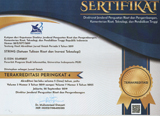Usulan Perbaikan Penilaian Kinerja Operator Produksi Menggunakan Metode Balance Scorecard Berdasarkan KPI di PT. Meidoh Indonesia
(1) Universitas Singaperbangsa Karawang
(2) Universitas Singaperbangsa Karawang
(3) Universitas Singaperbangsa Karawang
(*) Corresponding Author
Abstract
Based on the results of the observation, it was found that there is no definite benchmark for employee performance evaluation, especially in the production department at PT Meidoh Indonesia. Therefore, this research aims to identify and design performance assessments in the production department of PT Meidoh Indonesia. The method used is the Balance Scorecard method based on Key Performance Indicators (KPI). Essentially, the use of the balance scorecard method has 4 perspectives that will be structured into Key Performance Indicators (KPI). The result in this research, only 3 perspectives are used according to the company's conditions at that time. These 3 perspectives consist of the financial perspective with the Key Performance Indicator (KPI) of reducing purchases and production costs, the customer perspective with the Key Performance Indicator (KPI) of reducing the delay process, and the internal process perspective of improving workforce productivity, reducing scrap, and eliminating abnormal occurrences.
Keywords
Full Text:
PDFReferences
N. Anita, “Pengaruh Key Performance Indicator (Kpi) dan Lingkungan Kerja Terhadap Kinerja Karyawan Tazbiya Brands,” Jurnal Riset dan Inovasi Manajemen, vol. 1, no. 4, pp. 140–151, 2023, doi: 10.59581/jrim-widyakarya.v1i3.1440.
D. Hadiwijaya and E. Mintarsih, “Pengaruh Penilaian Kerja Dan Motivasi Kerja Terhadap Kinerja Karyawan Pada Perusahaan Daerah Air Minum Tirta Kerta Raharja Kabupaten Tangerang,” Jurnal Manajemen Bisnis, vol. 10, no. 2, pp. 269–273, 2021.
M. I. Rahayu, A. Rahayu, and D. Putri, “Sistem Pendukung Keputusan Penilaian Kinerja Karyawan Kontrak dengan Menggunakan Metode Simple Additive Weighting (Studi Kasus: PT.Tirta Sukses Perkasa),” Jurnal Teknologi Informasi dan Komunikasi, vol. 10, no. 1, pp. 25–34, 2021.
I. Rustiawan, S. Purwati, K. Kraugusteeliana, and A. Ady Bakri, “Teknik Penilaian Kinerja Karyawan Menggunakan Metode Behaviour Anchor Rating Scale dalam Pemeringkatan Karyawan Terbaik,” Jurnal Krisnadana, vol. 2, no. 3, pp. 403–411, 2023, [Online]. Available: https://ejournal.sidyanusa.org/index.php/jkdn
A. Surahman, “Penilaian Kinerja Karyawan Menggunakan Kombinasi Metode Multi-Objective Optimization by Ratio Analysis (MOORA) dan Pembobotan Entropy,” CHAIN: Journal of Computer Technology, Computer Engineering, vol. 2, no. 1, 2024, doi: 10.58602/chain.v2i1.93.
S. L. Riwu, A. Wibowo, and K. C. Budiyatno, “Penilaian Kinerja Rumah Sakit Dengan Menggunakan Pendekatan Balanced Scorecard: Systematic Review Assessment of Hospital Performance Using Balanced Scorecard Approach: Systematic Review,” Jurnal Manajemen Kesehatan Yayasan RS. Dr. Soetomo, vol. 7, no. 2, pp. 267–283, 2021, [Online]. Available: https://remote-lib.ui.ac.id,
A. R. Pitri, “The Implementation Of The Balanced Scorecard Method As A Yardware Of Company Performance Measurement At Cv. Bintang Bungo Fajar”, Jambi Accounting Review (JAR) JAR, vol. 3, no. 3, pp. 287–301, 2022, [Online]. Available: https://online-journal.unja.ac.id/JAR/
M. Ghufroni An and A. Kurniawan, “Sistem Informasi Manajemen Berbasis Key Performance Indicator (KPI) dalam Mengukur Kinerja Guru,” JDMSI, vol. 3, no. 1, pp. 2775–9660, 2022.
R. Akseptori, R. A. N. Yuniati, D. Maulana, and M. S. Dewi, “Key Performance Indicator Merujuk pada Perspektif Proses Bisnis Internal dan Perspektif Pembelajaran dan Pertumbuhan,” JURNAL NUSANTARA APLIKASI MANAJEMEN BISNIS, vol. 7, no. 1, pp. 118–134, Apr. 2022, doi: 10.29407/nusamba.v7i1.17396.
I. K. Saskara, A. R. M. Purwahita, and N. K. Sutrisnawati, “Implementasi Metode Key Performance Indicator (KPI) dalam Pengukuran Kinerja Receptionist Di Amadea Resort & Villa Seminyak,” Jurnal Kajian dan Terapan Pariwisata, vol. 3, no. 2, pp. 11–20, May 2023, doi: 10.53356/diparojs.v2i2.76.
R. Sholikha, “Penilaian Kinerja Karyawan Produksi Berbasis Key Performance Indikators (KPI),” Ekonomi dan Bisnis, vol. 2, no. 2, pp. 12–21, 2023, [Online]. Available: http://ejurnal.provisi.ac.id/index.php/JIMEB
I. W. S. Wibawa, N. P. Y. Astiti, I. P. JS Dwinata, and I. P. N. R. A. Andika, “Upaya Peningkatan Kesadaran Karyawan Pada Tim Marketing Menggunakan Kpi Pada PT. Herointi Nusa Cabang Kartini,” Prosiding Seminar Nasional Pengabdian Masyarakat Bali: Universitas Mahasaraswati Denpasar, Nov. 2023, pp. 857–862.
D. Eka Ratnawati and R. M. Regasari, “Penilaian Kinerja Karyawan Menggunakan Key Performance Indikator (KPI) pada AR Rohmah Islamic Boarding School Group,” Jurnal Pengabdian Masyarakat Teknologi Informasi dan Informatika (DIMASLOKA), vol. 2, no. 2, pp. 51–59, 2023, [Online]. Available: https://arrohmah.co.id/
F. Setiawan and T. Ardiansah, “Rancang Bangun Sistem Kepegawaian Menggunakan Metode Key Performance Indicator Untuk Rekomendasi Kenaikan Jabatan,” Journal of Artificial Intelligence and Technology Information (JAITI), vol. 1, no. 3, 2023, doi: 10.58602/jaiti.v1i3.65.
DOI: http://dx.doi.org/10.30998/string.v10i1.27793
Refbacks
- There are currently no refbacks.
Copyright (c) 2025 Rosida Azizah

This work is licensed under a Creative Commons Attribution 4.0 International License.
STRING (Satuan Tulisan Riset dan Inovasi Teknologi) indexed by:

Ciptaan disebarluaskan di bawah Lisensi Creative Commons Atribusi 4.0 Internasional.
View My Stats


 Sertifikat Akreditasi
Sertifikat Akreditasi
















